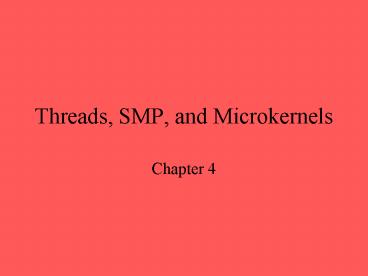Threads, SMP, and Microkernels - PowerPoint PPT Presentation
1 / 40
Title:
Threads, SMP, and Microkernels
Description:
These two characteristics can be treated independently by the operating system. Process ... Deallocate register context and stacks. Remote Procedure Call Using Threads ... – PowerPoint PPT presentation
Number of Views:43
Avg rating:3.0/5.0
Title: Threads, SMP, and Microkernels
1
Threads, SMP, and Microkernels
- Chapter 4
2
A Process embodies two Characteristics
- Resource ownership - process is allocated a
virtual address space to hold the process image - Scheduling/execution- follows an execution path
that may be interleaved with other processes - These two characteristics can be treated
independently by the operating system
3
Process
- Unit that is Dispatchable is referred to as a
thread - Unit of resource ownership is referred to as a
process or task
4
Multithreading
- Operating system supports multiple threads of
execution within a single process - MS-DOS supports a single thread
- UNIX supports multiple user processes but only
supports one thread per process - Windows 2000, Solaris, Linux, Mach, and OS/2
support multiple threads
5
(No Transcript)
6
Process
- Have a virtual address space which holds the
process image - Protected access to processors, other processes,
files, and I/O resources
7
Thread
- An execution state (running, ready, etc.)
- Saved thread context when not running
- an independent PC value within a process
- Has an execution stack
- Some per-thread static storage for local
variables - Access to the memory and resources of its process
- all threads of a process share this
8
Thread
- Idea all threads in a process share the same
code - execute the same program
- each thread has separate local variables
- an independent execution stack
9
(No Transcript)
10
Benefits of Threads
- Takes less time to create a new thread than a
process - Less time to terminate a thread than a process
- Less time to switch between two threads within
the same process - Since threads within the same process share
memory and files, they can communicate with each
other without invoking the kernel
11
Uses of Threads in a Single-User Multiprocessing
System
- Foreground to background work
- Asynchronous processing
- such as periodic buffer flush to disk, ...
- To speed-up execution
- Modular program structure
12
Threads
- Suspending a process involves suspending all
threads of the process since all threads share
the same address space - Termination of a process, terminates all threads
within the process
13
Thread States
- Operations associated with a change in thread
state - Spawn
- Spawn another thread
- Block
- Unblock
- Finish
- Deallocate register context and stacks
14
Remote Procedure Call Using Threads
15
Remote Procedure Call Using Threads
16
User-Level Threads
- All thread management is done by the application
- The kernel is not aware of the existence of
threads
17
Kernel-Level Threads
- W2K, Linux, and OS/2 are examples of this
approach - Kernel maintains context information for the
process and the threads - Scheduling is done on a thread basis
18
Combined Approaches
- Example is Solaris
- Thread creation done in the user space
- Bulk of scheduling and synchronization of threads
done in the user space
19
(No Transcript)
20
Relationship Between Threads and Processes
ThreadsProcess
Description
Example Systems
Traditional UNIX implementations
11
Each thread of execution is a unique process with
its own address space and resources.
M1
A process defines an address space and dynamic
resource ownership. Multiple threads may be
created and executed within that process.
Windows NT, Solaris, OS/2, OS/390, MACH
21
Relationship Between Threads and Processes
ThreadsProcess
Description
Example Systems
1M
A thread may migrate from one process environment
to another. This allows a thread to be easily
moved among distinct systems.
Ra (Clouds), Emerald
TRIX
MM
Combines attributes of M1 and 1M cases
22
Categories of Computer Systems
- Single Instruction Single Data (SISD)
- single processor executes a single instruction
stream to operate on data stored in a single
memory - Single Instruction Multiple Data (SIMD)
- each instruction is executed on a different set
of data by the different processors
23
Categories of Computer Systems
- Multiple Instruction Single Data (MISD)
- a sequence of data is transmitted to a set of
processors, each of which executes a different
instruction sequence. Never implemented - Multiple Instruction Multiple Data (MIMD)
- a set of processors simultaneously execute
different instruction sequences on different data
sets
24
(No Transcript)
25
Symmetric Multiprocessing
- Kernel can execute on any processor
- Typically each processor does self-scheduling
from the pool of available processes or threads
26
(No Transcript)
27
Multiprocessor Operating System Design
Considerations
- Simultaneous concurrent processes or threads
- Scheduling
- Synchronization
- Memory Management
- Reliability and Fault Tolerance
28
(No Transcript)
29
Windows 2000Process Object
30
Windows 2000Thread Object
31
Windows 2000Thread States
- Ready
- Standby
- Running
- Waiting
- Transition
- Terminated
32
(No Transcript)
33
Solaris
- Process includes the users address space, stack,
and process control block - User-level threads
- Lightweight processes
- Kernel threads
34
(No Transcript)
35
(No Transcript)
36
Solaris Thread Execution
- Synchronization
- Suspension
- Preemption
- Yielding
37
(No Transcript)
38
Linux Process
- State
- Scheduling information
- Identifiers
- Interprocess communication
- Links
- Times and timers
- File system
- Virtual memory
- Processor-specific context
39
Linux States of a Process
- Running
- Interruptable
- Uninterruptable
- Stopped
- Zombie
40
(No Transcript)

